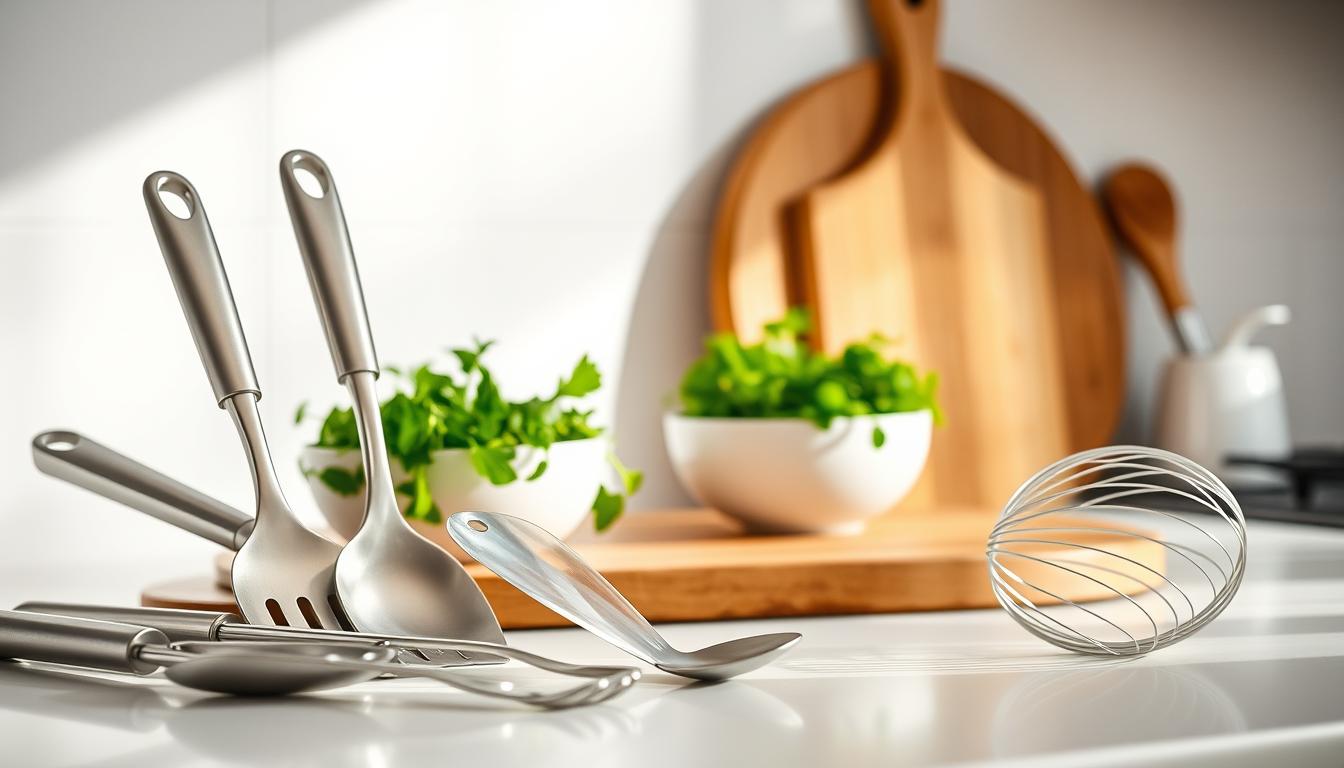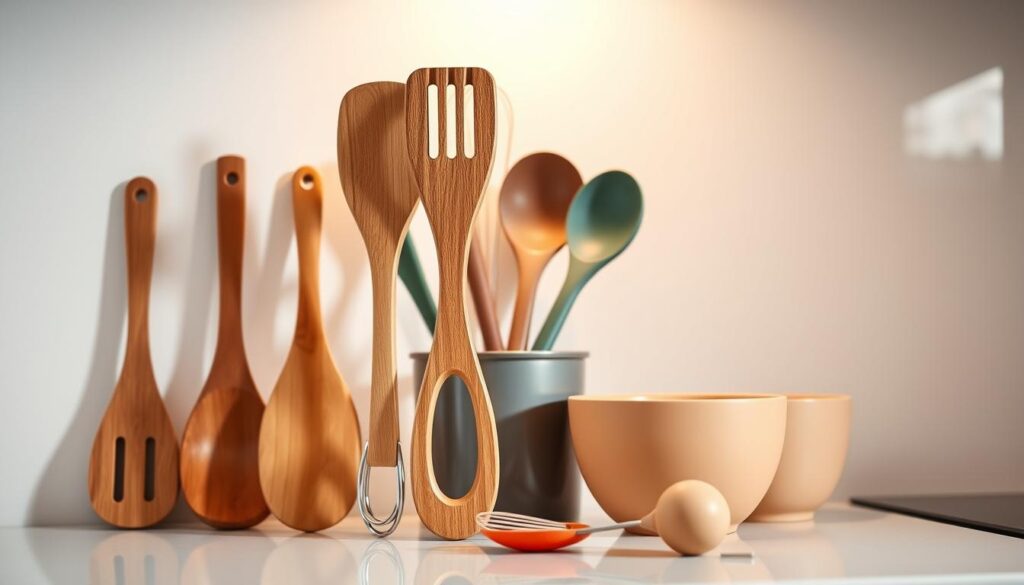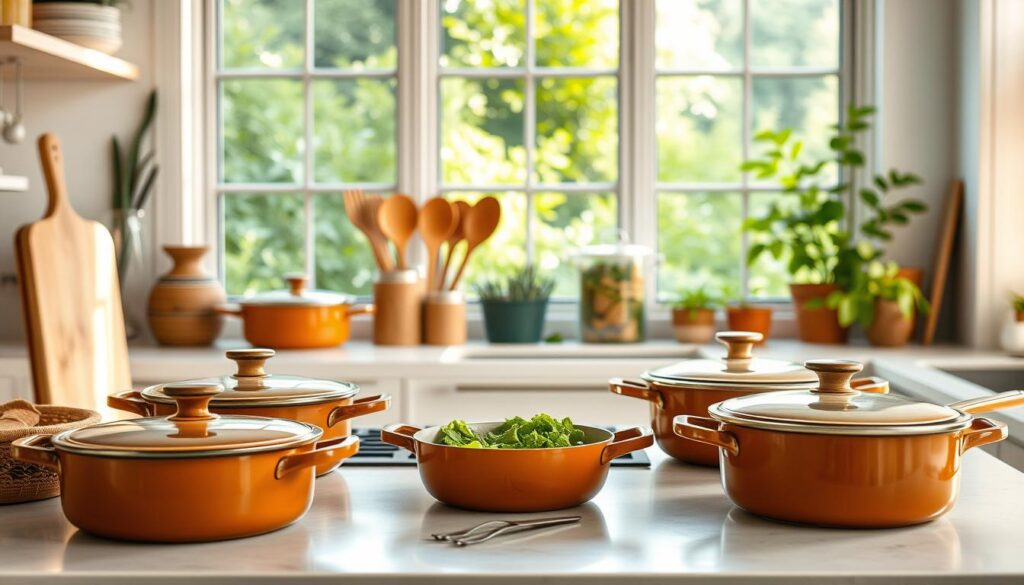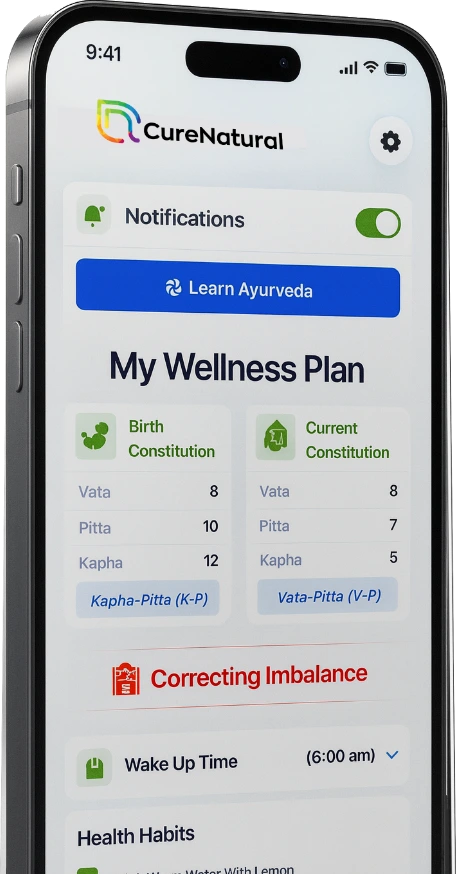Introduction: When Healthy Food Isn’t Enough and Why You Need Non Toxic Utensils
Most of us spend time choosing organic produce, plant-based proteins, and clean ingredients, believing that healthy food automatically leads to a healthy body. But the truth is more complicated. Health is not just about what you eat. It’s also about how that food is cooked, stored, and handled every day in your kitchen.
Ayurveda has always viewed the kitchen as the body’s first pharmacy. Food carries a living energy called Prana, and everything that touches it — from the pot on the stove to the spatula in your hand — affects that energy. Modern science now echoes this wisdom. Materials like nonstick coatings, plastics, and reheating methods can introduce chemicals or reduce the nutrient and energetic value of food before it even reaches your plate.
When I talk to patients who say, “I eat healthy but still feel tired or bloated,” I often find that the issue lies not in the food itself but in their kitchen habits. The cookware, utensils, and storage materials we use daily can quietly interfere with digestion, hormones, and vitality. The good news is that you don’t need a brand-new kitchen to fix it — only awareness and small, thoughtful changes toward non toxic utensils, healthy cooking utensils, and non toxic healthy cookware that honor both science and Ayurveda.
The Cookware Problem: What’s Hiding in Your Pans
Nonstick and PFAS Exposure
Nonstick cookware is one of the biggest hidden health offenders. The convenience of a pan that wipes clean hides a deeper issue: most traditional nonstick coatings contain PFAS or PFOA — synthetic compounds often called “forever chemicals” because they don’t easily break down in the environment or the body. When overheated, these coatings can release fumes and microscopic particles that may affect hormone balance, thyroid function, and immunity.
Ayurveda might describe this as disturbing the body’s Agni, the digestive fire that governs transformation and metabolism. A weak or unstable Agni leads to fatigue, sluggish digestion, and toxin buildup. The solution starts with replacing these reactive surfaces with healthy pans made from safer materials.
Healthier Cookware Alternatives
Cast iron provides trace iron naturally and develops a naturally nonstick surface when seasoned.
Stainless steel is durable, non-reactive, and ideal for everyday cooking.
Clay and earthen pots distribute heat gently and retain moisture, helping food stay soft and digestible.
Ceramic or enamel coatings, when certified lead-free, are excellent for baking and gentle reheating.
Copper has antimicrobial properties but should be lined with tin or stainless steel to prevent excess metal leaching.
These options are examples of non toxic healthy cookware that interact harmoniously with food. Ayurveda values these materials because they reflect the Earth and Fire elements — grounding and stable — which preserve the vitality (Prana) of a meal rather than disrupting it.
Toxic Metals and Poor Quality Cookware
Low-quality aluminum pots or cheap metal alloys can leach ions into food, especially when cooking acidic ingredients like tomatoes or lemon juice. Over time, this constant low-level exposure adds stress to the liver and kidneys. Choosing healthy pots made from stable, food-grade metals protects digestion and supports long-term health.
Plastics and Food Storage: The Hidden Hormone Disruptors
Even when cooking surfaces are safe, many people unknowingly compromise their food afterward. Storing hot leftovers in plastic containers, reheating takeout in plastic bowls, or drinking from plastic bottles can expose the body to BPA, BPS, and phthalates — chemicals that mimic natural hormones.
These compounds are linked to fertility issues, thyroid imbalance, and metabolic disorders. From an Ayurvedic standpoint, they generate Ama, or toxic residue, by introducing substances the body cannot fully process. Over time, Ama clogs the body’s channels (Srotas), leading to fatigue, weight gain, or foggy thinking.
Healthier Storage Solutions
Replace plastic containers with glass or ceramic. Both are non-reactive, preserve flavor, and maintain the food’s energetic purity (Sattva).
Stainless-steel lunch boxes are ideal for carrying meals without chemical risk.
Avoid covering hot dishes with plastic wrap. Use beeswax wraps, parchment, or silicone lids instead.
Build a small non toxic utensils set that includes wooden spoons, glass jars, and bamboo tongs for serving and storage.
These changes keep meals free from chemical residues and support hormonal balance. They also align with sustainability — another Ayurvedic principle of living in harmony with nature.
Microwaving and the Loss of Food Vitality
Microwaves are modern convenience at its peak, but they also raise questions about how they affect the energetic and structural integrity of food. Microwaves heat by rapidly vibrating water molecules, which can cause uneven temperature zones and break delicate nutrient bonds. Research shows that certain vitamins, such as vitamin C and some B vitamins, degrade faster when exposed to microwave radiation.
Ayurveda goes beyond nutrient count and looks at the quality of energy. Food heated this way is considered to have reduced Prana — its natural life force — and takes more effort for the body to digest. Many people report feeling hungry again soon after eating microwaved meals, which Ayurveda would interpret as weak Agni.
Better Ways to Reheat Food
If you rely on quick reheating, consider these alternatives:
Use a small pot or pan with a splash of water or broth.
Try a countertop steamer for rice, grains, or vegetables.
A toaster oven reheats food evenly without destroying texture.
Each of these methods helps retain warmth, aroma, and digestibility. And when you use non toxic utensils or healthy cooking utensils — such as wooden spatulas or stainless-steel ladles — you avoid introducing additional contaminants.
The Frozen Food Trap
Frozen foods save time, but Ayurveda would remind us that cold and static energy increases Vata dosha, which governs movement, air, and nerve activity. Too much Vata leads to dryness, constipation, anxiety, or restless sleep. From a nutritional perspective, frozen food loses enzyme activity and texture integrity, meaning your body must work harder to extract nutrients.
If freezing is necessary, do it with awareness: store food in airtight glass containers, label and date them, and consume within a reasonable period. When reheating, bring the food back to life by adding warm water, ghee, or digestive spices such as cumin, ginger, or black pepper. This simple step revives Prana and supports digestion.
Cooking Oils: The Good, the Bad, and the Oxidized
Healthy oils are essential to both modern nutrition and Ayurveda. They lubricate tissues, balance hormones, and keep digestion smooth. But the type of oil and how it’s used matters just as much as the ingredient itself.
When Healthy Turns Harmful
Many “heart-healthy” refined seed oils — corn, soybean, sunflower — become unstable at high heat. Reusing the same oil for frying creates aldehydes and free radicals that promote inflammation. Even olive oil, though beneficial raw, oxidizes when overheated.
From an Ayurvedic viewpoint, rancid or overheated oils disturb Pitta dosha (the fire element) and create internal heat that can show up as skin irritation, acidity, or mood swings.
Oils That Support Digestion and Longevity
Ghee (clarified butter): Highly stable, enhances Agni, and carries nutrients deep into tissues.
Coconut oil: Cooling, ideal for Pitta and tropical climates.
Sesame oil: Warming, grounding, and excellent for Vata types.
Avocado oil: High smoke point and rich in monounsaturated fats.
Pairing the right oil with healthy pans made from stainless steel or cast iron prevents oxidation and chemical reactivity. Ayurveda calls this harmony between material, element, and intention — the art of cooking with consciousness.
Utensils, Cutting Boards, and Everyday Tools
The small things matter just as much as the big ones. Many people pay attention to pots and pans but ignore utensils. Worn plastic spatulas, old silicone molds, or scratched nonstick tools can release microplastics into food. Even tiny exposures accumulate over years.
Ayurveda would see this as another source of Ama, subtle toxins that weaken immunity and disturb mental clarity.
Building a Non Toxic Kitchen Toolkit
Start with the essentials:
Wooden or bamboo spoons: gentle on cookware, naturally antimicrobial.
Stainless-steel ladles and whisks: durable, easy to clean, non-reactive.
Glass or ceramic mixing bowls: preserve flavor and temperature balance.
Natural fiber brushes or loofahs: avoid synthetic sponges that harbor bacteria.
Together these form the foundation of a non toxic utensils set that keeps your kitchen functional, beautiful, and safe.
Cutting boards deserve attention too. Old plastic boards release micro-shavings over time, especially when scored with knives. Bamboo or hardwood boards are safer, renewable, and even smell better. Maintaining them with a bit of coconut or mineral oil extends their life and keeps your kitchen aligned with Ayurveda’s respect for natural materials.
Mindful Cooking: Energy Behind Every Meal
When you step into your kitchen, you bring more than ingredients and utensils. You bring your energy. The tone of your thoughts, your mood, and even the way you stir food all shape how nourishing that meal becomes. Ayurveda explains this through the concept of Gunas — the three qualities of energy that affect both mind and matter.
Sattva: calm, clarity, balance
Rajas: restlessness, activity, intensity
Tamas: dullness, inertia, heaviness
Cooking in a Sattvic state means preparing food with presence, gratitude, and focus. When we cook with frustration, hurry, or distraction, that Rajas or Tamas energy subtly transfers into the food. Modern research now supports this ancient view: the cook’s emotional state affects cortisol levels, which in turn influence digestion and the parasympathetic nervous system.
This is why mindful cooking is more than a spiritual ideal. It’s a physiological necessity. Eating food cooked with attention and care signals safety to the body, activates rest-and-digest mode, and improves nutrient absorption.
Creating a Sattvic Kitchen Environment
Start small:
Take one deep breath before beginning to cook.
Keep your cooking area clean, uncluttered, and well-lit with natural light.
Play soothing music or simply let your kitchen stay quiet.
Offer a moment of gratitude before the first bite.
Cooking with healthy cooking utensils made of wood, bamboo, or stainless steel supports this calm energy. These natural materials connect the cook to the elements — Earth, Fire, and Water — rather than separating food from its natural vibration. Ayurveda teaches that when the cook’s energy is centered, the food becomes medicine for both body and mind.
Aligning Your Cooking Routine with Nature’s Clock
Ayurveda views digestion as an extension of cosmic rhythm. The strength of your Agni (digestive fire) rises and falls with the sun, which means timing matters as much as the ingredients themselves.
Morning (7–9 am): Gentle, easy-to-digest food such as oatmeal, fruit, or warm herbal tea.
Midday (12–1 pm): Main meal of the day when Agni is strongest — cooked grains, vegetables, and proteins prepared in non toxic healthy cookware that retains warmth.
Evening (6–7 pm): Light and calming foods such as soups or stews, ideally eaten before dark to avoid sluggish digestion.
This simple rhythm supports both your internal clock and your microbiome. It also prevents the late-night cravings and heaviness that so many people mistake for “slow metabolism.”
Dosha-Specific Kitchen Guidance
Every person has a unique mind-body type, or Dosha, made up of the five elements. The kitchen, like medicine, can help balance those energies. Here’s how:
Vata (Air + Space)
Tendencies: Irregular digestion, dryness, bloating, anxiety.
Supportive cookware: Clay pots, cast iron, stainless steel — all retain warmth and moisture.
Kitchen advice: Favor warm, oily meals; avoid cold or leftover food. Choose heavy, grounding utensils and stable routines.
Pitta (Fire + Water)
Tendencies: Heartburn, irritability, skin inflammation.
Supportive cookware: Ceramic or stainless steel; avoid copper and cast iron that add heat.
Kitchen advice: Keep meals cooling and hydrating. Cook calmly and avoid overly spicy or fried foods.
Kapha (Earth + Water)
Tendencies: Sluggish digestion, congestion, fatigue.
Supportive cookware: Stainless steel, ceramic, or clay. Avoid heavy, oily pans that retain grease.
Kitchen advice: Favor light, dry cooking methods like baking or sautéing with minimal oil. Keep your kitchen bright and active to counter slow energy.
These distinctions go beyond preference. Ayurveda views the material of your cookware, the method of preparation, and even your pace in the kitchen as tools to balance your Dosha.
The Truth About “Green” and “Eco-Friendly” Labels
With rising awareness about toxins, brands are quick to label products as “non-toxic,” “eco,” or “Ayurvedic-inspired.” Unfortunately, many of these terms mean little without third-party verification.
Watch for Marketing Red Flags
Vague claims like “sustainable” or “chemical-free.”
Bright ceramic coatings that may contain lead or cadmium.
“Microwave safe” plastics that degrade with time and heat.
Cookware labeled “PFOA-free” but still containing PFAS substitutes just as harmful.
Certifications That Matter
Look for verified standards like:
California Proposition 65 compliance (lead and cadmium limits).
FDA food-contact safety or LFGB certification (Europe).
BPA-free / PFAS-free on packaging, ideally with documentation from the manufacturer.
Simplify your choices: if a product’s composition isn’t transparent, skip it. Ayurveda and common sense agree that simplicity is safety. The fewer coatings and synthetic layers between food and your cookware, the closer your meal stays to its natural, healing state.
Budget-Friendly Ways to Detoxify Your Kitchen
You don’t need to replace everything overnight. Begin with what touches your food most often — your daily pan, your favorite spatula, your storage containers. Replace them with non toxic utensils and healthy pots one step at a time.
Practical starting points:
Cookware: Trade one nonstick pan for cast iron or stainless steel.
Utensils: Build a small non toxic utensils set of bamboo spoons and stainless-steel ladles.
Storage: Replace plastic with glass or ceramic for leftovers.
Cleaning: Swap synthetic sponges for natural brushes or loofahs.
Air quality: Avoid aerosol cleaners and fragrances in the kitchen; use vinegar, lemon, or baking soda instead.
These changes reduce both chemical exposure and sensory overload. The result is a cleaner, calmer environment that naturally supports digestive fire and mental focus.
A Modern Kitchen through an Ayurvedic Lens
The beauty of Ayurveda is that it doesn’t ask you to reject modern life — it asks you to make it conscious. You can have a blender, refrigerator, and induction cooktop and still live Ayurvedically if you understand energy.
It’s not about nostalgia for ancient clay pots but about awareness. When you cook with non toxic healthy cookware, you reduce the burden of synthetic energy. If you slow down to chop vegetables with attention, you balance Rajas. Finally, sitting down to eat without your phone, you honor Sattva.
The point is not perfection, but presence.
The Energetics of Digestion: Beyond Calories
Modern nutrition often focuses on macros and micronutrients, but Ayurveda sees food as consciousness condensed into matter. Your body doesn’t just digest food — it digests information, emotion, and environment.
That’s why food eaten in front of screens often leaves you unsatisfied even if it’s nutritious. The sensory overload scatters energy, confusing both your brain and your gut. Studies show that mindful eating increases satisfaction and improves portion control. Ayurveda framed this centuries ago: focus, calm, and gratitude are part of digestion.
So the next time you cook, treat it like meditation in motion. The sound of sizzling ghee, the scent of fresh ginger, the warmth of your hands — these are not trivial details. They are the language your body understands.
A Checklist for a Conscious Kitchen
Cookware:
Choose non toxic healthy cookware such as cast iron, stainless steel, or clay.
Avoid old nonstick pans with peeling coatings.
Keep cookware clean and dry to prevent rust or residue buildup.
Utensils:
Use non toxic utensils made from wood, bamboo, or stainless steel.
Replace plastic spoons and spatulas showing wear.
Maintain a compact, high-quality non toxic utensils set instead of a drawer full of disposable tools.
Storage:
Switch to glass or ceramic containers for leftovers.
Never store hot food in plastic.
Avoid microwaving in any plastic or non-tempered containers.
Cooking oils:
Favor ghee, coconut, sesame, or avocado oils for heat stability.
Avoid reusing fried oil or cooking with refined seed oils.
Daily routine:
Eat your main meal at midday when Agni is strongest.
Reheat food gently, preserving Prana.
Express gratitude before and after meals.
These habits may sound small, but they rebuild your health from the foundation up — your kitchen.
Reflection: The Kitchen as a Place of Healing
True wellness doesn’t begin with supplements or fitness trackers. It begins with awareness — of how we prepare, handle, and relate to our food. Every choice in your kitchen is a message to your body.
When we cook with healthy cooking utensils, avoid toxins, and bring calm presence to our meals, we do more than eat clean. We reconnect with the intelligence of nature that Ayurveda calls Prana.
So before you invest in another superfood powder, look closer to home. Your most powerful medicine may already be sitting on your stove.






